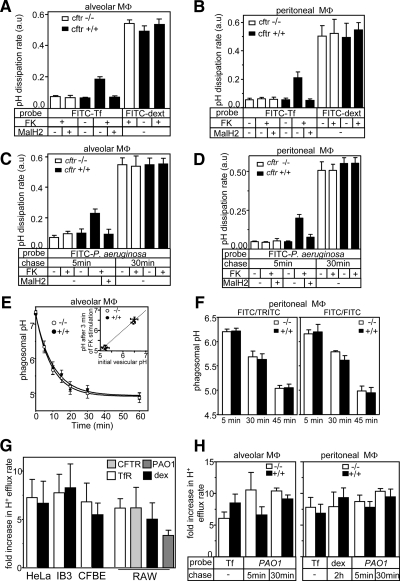Figure 7.
Acidification of phagosomes in CFTR-deficient primary alveolar (AM) and peritoneal (PM) macrophages is preserved. (A and B) CFTR is active in early endosomes, but not in lysosomes, of primary alveolar and peritoneal mouse macrophages from cftr+/+ mice. pH dissipation rates were measured in FITC-Tf– or FITC/Oregon488-dextran–loaded endosomes and lysosomes, respectively in macrophages isolated from cftr+/+ or cftr−/− mice. Tf and dextran labeling was described in Materials and Methods. MalH2, 20 μM, was added to inhibit CFTR during labeling, and the measurement. pH dissipation rates were measured after Baf and CCCP addition as described in Figure 2E. (C and D) CFTR can be activated in immature phagosomes of cftr+/+ macrophages. pH dissipation rates of phagosomes ingesting FITC-labeled PAO1 was measured after 5 and 30 min of infection. MalH2, 20 μM, was added during phagocytosis. (E) Phagosomal acidification kinetics of cftr+/+ and cftr−/− alveolar macrophages are similar. Acidification of phagosomes, synchronously ingesting FITC-PAO1, was monitored by FRIA. Inset, the variation of immature and mature phagosomal pH after 3 min PKA stimulation is reported as the function of the initial pH. (F) Comparison of phagosomal pH of cftr+/+ and cftr−/− peritoneal macrophages by FRIA of FITC or FITC- and TRITC-labeled PAO1. Phagocytosis was initiated synchronously and the duration (5–45 min) is indicated. Means ± SEM; n = 4 mice. (G) Protonophore-induced increase of the pH dissipation rate of endosomes and lysosomes relative to the passive proton efflux rate as an indicator of counterion permeability. The pH dissipation rates of FITC-Tf– and FITC-dextran–loaded recycling endosomes and lysosomes, respectively, were measured by FRIA in the presence of Baf alone and Baf+ CCCP as in Figure 2, D and E. CFTR-expressing HeLa, RAW and respiratory epithelia (CFBE and IB3) were used. Baf+CCCP simultaneous addition yielded results similar to those obtained by consecutive addition with 1-min delay. Results expressed as fold increase of the CCCP+Baf–induced proton efflux rate over that of the passive proton release. (H) Protonophore-induced increase of the pH dissipation rate relative to the passive proton efflux rate of endocytic organelles in primary macrophages. Baf- and Baf+CCCP–induced pH dissipation rates of recycling endosomes, lysosomes as well as immature and mature phagosomes were measured by the FRIA using the indicated pH-sensitive probe as described in Materials and Methods and in G. Means ± SEM; n = 4 mice.

